Multifunctional Carbon Dots-Based Fluorescence Detection for Sudan I, Sudan IV and Tetracycline Hydrochloride in Foods
Abstract
:1. Introduction
2. Experimental
2.1. Chemicals
2.2. Synthesis of B-CDs
2.3. Apparatus and Characterization
2.4. Experimental Method
2.5. Samples Analysis
3. Results and Discussion
3.1. Characterization of B-CDs
3.2. Optical Properties of B-CDs
3.3. Fluorescence Properties of B-CDs
3.4. Detection of Sudan Ⅰ Based on B-CDs
3.5. Detection of Sudan Ⅳ Based on B-CDs
3.6. Detection of TC Based on B-CDs
3.7. Mechanism Discussion
3.8. Application of B-CDs in Actual Samples
4. Conclusions
Author Contributions
Funding
Institutional Review Board Statement
Informed Consent Statement
Data Availability Statement
Conflicts of Interest
References
- Chailapakul, O.; Wonsawat, W.; Siangproh, W.; Grudpan, K.; Zhao, Y.F.; Zhu, Z.W. Analysis of Sudan I, Sudan II, Sudan III, and Sudan IV in food by HPLC with electrochemical detection: Comparison of glassy carbon electrode with carbon nanotube-ionic liquid gel modified electrode. Food Chem. 2008, 109, 876–882. [Google Scholar] [CrossRef] [PubMed]
- Tajik, S.; Aflatoonian, M.R.; Shabanzade, R.; Beitollahi, H.; Alizadeh, R. Amplified electrochemical sensor employing ZnO-CuO nanoplates for sensitive analysis of Sudan I. Int. J. Environ. Anal. Chem. 2019, 100, 109–120. [Google Scholar] [CrossRef]
- Andoh, S.S.; Nuutinen, T.; Mingle, C.; Roussey, M. Qualitative analysis of Sudan IV in edible palm oil. J. Eur. Opt. Soc. Rapid Publ. 2019, 15, 1–5. [Google Scholar] [CrossRef] [Green Version]
- Yang, X.; Guo, Y.; Liang, S.; Hou, S.; Chu, T.; Ma, J.; Chen, X.; Zhou, J.; Sun, R. Preparation of sulfur-doped carbon quantum dots from lignin as a sensor to detect Sudan I in an acidic environment. J. Mater. Chem. B 2020, 8, 10788–10796. [Google Scholar] [CrossRef]
- Huang, S.T.; Yang, L.F.; Li, N.B.; Luo, H.Q. An ultrasensitive and selective fluorescence assay for Sudan I and III against the influence of Sudan II and IV. Biosens. Bioelectron. 2013, 42, 136–140. [Google Scholar] [CrossRef]
- Bai, F.; Bu, T.; Zhang, M.; Tian, Y.; Sun, X.; Jia, P.; Zhang, Y.; Li, R.; Zhao, S.; He, K.; et al. Rhombic-like Al nanosupporter-based fluorescent immunochromatographic assay for the sensitive detection of tetracycline. Sen. Actuators B Chem. 2020, 324, 128721. [Google Scholar] [CrossRef]
- Xiong, Y.; Zhou, H.; Zhang, Z.; He, D.; He, C. Molecularly imprinted on-line solid-phase extraction combined with flow-injection chemiluminescence for the determination of tetracycline. Analyst 2006, 131, 829–834. [Google Scholar] [CrossRef]
- Zhang, Y.; Zhang, Z.; Sun, Y. Development and optimization of an analytical method for the determination of Sudan dyes in hot chilli pepper by high-performance liquid chromatography with on-line electrogenerated BrO--luminol chemiluminescence detection. J. Chromatogr. A 2006, 1129, 34–40. [Google Scholar] [CrossRef]
- Long, C.; Mai, Z.; Yang, X.; Zhu, B.; Xu, X.; Huang, X.; Zou, X. A new liquid–liquid extraction method for determination of 6 azo-dyes in chilli products by high-performance liquid chromatography. Food Chem. 2011, 126, 1324–1329. [Google Scholar] [CrossRef]
- Shariati, S.; Yamini, Y.; Esrafili, A. Carrier mediated hollow fiber liquid phase microextraction combined with HPLC-UV for preconcentration and determination of some tetracycline antibiotics. J. Chromatogr. B 2009, 877, 393–400. [Google Scholar] [CrossRef]
- Mejia, E.; Ding, Y.; Mora, M.F.; Garcia, C.D. Determination of banned Sudan dyes in chili powder by capillary electrophoresis. Food Chem. 2007, 102, 1027–1033. [Google Scholar] [CrossRef]
- Ibarra, I.S.; Rodriguez, J.A.; Miranda, J.M.; Vega, M.; Barrado, E. Magnetic solid phase extraction based on phenyl silica adsorbent for the determination of tetracyclines in milk samples by capillary electrophoresis. J. Chromatogr. A 2011, 1218, 2196–2202. [Google Scholar] [CrossRef] [PubMed]
- Verhagen, A.; Kelarakis, A. Carbon Dots for Forensic Applications: A Critical Review. Nanomaterials 2020, 10, 1535. [Google Scholar] [CrossRef]
- Sun, X.C.; Yu, L. Fluorescent carbon dots and their sensing applications. TrAC Trends Anal. Chem. 2017, 89, 163–180. [Google Scholar] [CrossRef]
- Shi, X.B.; Wei, W.; Fu, Z.D.; Gao, W.L.; Zhang, C.Y.; Zhao, Q.; Deng, F.M.; Lu, X.Y. Review on carbon dots in food safety applications. Talanta 2019, 194, 809–821. [Google Scholar] [CrossRef] [PubMed]
- Tang, X.D.; Yu, H.M.; Bui, B.L.; Wang, Y.; Xing, C.; Wang, S.Y.; Chen, M.L.; Hu, Z.Z.; Chen, W. Nitrogen-doped fluorescence carbon dots as multi-mechanism detection for iodide and curcumin in biological and food samples. Bioact. Mater. 2021, 6, 1541–1554. [Google Scholar] [CrossRef] [PubMed]
- Xu, Y.; Yu, H.M.; Chudal, L.; Pandey, N.K.; Amador, E.H.; Bui, B.; Wang, L.Y.; Ma, X.D.; Deng, S.P.; Zhu, X.H.; et al. Striking luminescence phenomena of carbon dots and their applications as a double ratiometric fluorescence probes for H2S detection. Mater. Today Phy. 2021, 17, 100328. [Google Scholar] [CrossRef]
- Tang, X.D.; Wang, H.Y.; Yu, H.M.; Bui, B.; Zhang, W.; Wang, S.Y.; Chen, M.L.; Yuan, L.Q.; Hu, Z.Z.; Chen, W. Exploration of nitrogen-doped grape peels carbon dots for baicalin detection. Mater. Today Phy. 2022, 22, 100576. [Google Scholar] [CrossRef]
- Zhao, D.; Zhang, Z.; Liu, X.; Zhang, R.; Xiao, X. Rapid and low-temperature synthesis of N, P co-doped yellow emitting carbon dots and their applications as antibacterial agent and detection probe to Sudan Red I. Mater. Sci. Eng. C 2021, 119, 111468. [Google Scholar] [CrossRef]
- Uriarte, D.; Domini, C.; Garrido, M. New carbon dots based on glycerol and urea and its application in the determination of tetracycline in urine samples. Talanta 2019, 201, 143–148. [Google Scholar] [CrossRef]
- Yan, Y.; Liu, J.H.; Li, R.S.; Li, Y.F.; Huang, C.Z.; Zhen, S.J. Carbon dots synthesized at room temperature for detection of tetracycline hydrochloride. Anal. Chim. Acta 2019, 1063, 144–151. [Google Scholar] [CrossRef] [PubMed]
- Mahmoudi-Moghaddam, H.; Tajik, S.; Beitollahi, H. Highly sensitive electrochemical sensor based on La3+-doped Co3O4 nanocubes for determination of Sudan I content in food samples. Food Chem. 2019, 286, 191–196. [Google Scholar] [CrossRef] [PubMed]
- Genualdi, S.; MacMahon, S.; Robbins, K.; Farris, S.; Shyong, N.; DeJager, L. Method development and survey of Sudan I–IV in palm oil and chilli spices in the Washington, DC,area. Food Addit. Contam. Part A 2016, 33, 583–591. [Google Scholar] [CrossRef] [PubMed]
- Li, Z.Z.; Wu, M.X.; Ding, S.N. Anodic near-infrared electrochemiluminescence from Cu-doped CdTe quantum dots for tetracycline detection. Anal. Methods 2021, 13, 2297–2304. [Google Scholar] [CrossRef] [PubMed]
- Kainth, S.; Maity, B.; Basu, S. Deciphering the interaction of solvents with dual emissive carbon dots: A photoluminescence study and its response for different metal ions. Mater. Sci. Eng. C 2020, 108, 110443. [Google Scholar] [CrossRef] [PubMed]
- Miao, X.; Qu, D.; Yang, D.X.; Nie, B.; Zhao, Y.K.; Fan, H.Y.; Sun, Z.C. Synthesis of carbon dots with multiple color emission by controlled graphitization and surface functionalization. Adv. Mater. 2018, 30, 1704740. [Google Scholar] [CrossRef] [PubMed]
- Leng, F.; Zhao, X.J.; Wang, J.; Li, Y.F. Visual detection of tetracycline antibiotics with the turned on fluorescence induced by a metal-organic coordination polymer. Talanta 2013, 107, 396–401. [Google Scholar] [CrossRef]
- Shen, Z.; Zhang, C.; Yu, X.; Li, J.; Wang, Z.; Zhang, Z.; Liu, B. Microwave-assisted synthesis of cyclen functional carbon dots to construct a ratiometric fluorescent probe for tetracycline detection. J. Mater. Chem. C 2018, 6, 9636–9641. [Google Scholar] [CrossRef]
- Lin, M.; Zou, H.Y.; Yang, T.; Liu, Z.X.; Liu, H.; Huang, C.Z. An inner filter effect based sensor of tetracycline hydrochloride as developed by loading photoluminescent carbon nanodots in the electrospun nanofibers. Nanoscale 2016, 8, 2999–3007. [Google Scholar] [CrossRef]
- Guo, F.; Zhu, Z.; Zheng, Z.; Jin, Y.; Di, X.; Xu, Z.; Guan, H. Facile synthesis of highly efficient fluorescent carbon dots for tetracycline detection. Environ. Sci. Pollut. Res. Int. 2020, 27, 4520–4527. [Google Scholar] [CrossRef]
- Ding, H.; Yu, S.B.; Wei, J.S.; Xiong, H.M. Full-Color Light-Emitting Carbon Dots with a Surface-State-Controlled Luminescence Mechanism. ACS Nano 2016, 10, 484–491. [Google Scholar] [CrossRef] [PubMed]
- Liu, Y.; Liu, B.; Huang, P.; Wu, F.Y.; Ma, L. Concentration-dependent photoluminescence carbon dots for visual recognition and detection of three tetracyclines. Anal. Bioanal. Chem. 2021, 413, 2565–2575. [Google Scholar] [CrossRef] [PubMed]
- Kang, C.; Huang, Y.; Yang, H.; Yan, X.F.; Chen, Z.P. A review of carbon dots produced from biomass wastes. Nanomaterials 2020, 10, 2316. [Google Scholar] [CrossRef] [PubMed]
- Jose, A.R.; Sivasankaran, U.; Menon, S.; Kumar, K.G. A silicon nanoparticle based turn off fluorescent sensor for sudan I. Anal. Methods 2016, 8, 5701–5706. [Google Scholar] [CrossRef]
- Sheth, S.; Li, M.; Song, Q. Luminescent Chemosensor Based on Ru(II) Bipyridine Complex for Detection of Sudan I through Inner Filter Effect. J. Fluoresc. 2020, 30, 1543–1551. [Google Scholar] [CrossRef]
- Liu, J.; Zhou, Z.; Wang, L.; Xu, M. Using a 1,8-diamino naphthalene–copper (II) system as a turn-on fluorescence probe for detecting Sudan I. Spectrosc. Lett. 2017, 50, 411–416. [Google Scholar] [CrossRef]
- Wu, C.; Lu, Q.; Miu, X.; Fang, A.; Li, H.; Zhang, Y. A simple assay platform for sensitive detection of Sudan I-IV in chilli powder based on CsPbBr3 quantum dots. J. Food Sci. Technol. 2018, 55, 2497–2503. [Google Scholar] [CrossRef]
- Liu, M.L.; Chen, B.B.; Yang, T.; Wang, J.; Liu, X.D.; Huang, C.Z. One-pot carbonization synthesis of europium-doped carbon quantum dots for highly selective detection of tetracycline. Methods Appl. Fluoresc. 2017, 5, 015003. [Google Scholar] [CrossRef]
- Gu, B.; Chen, D.; Gao, B.; Liu, Z.; Wang, Z.; Wang, T.; Yang, Y.; Guo, Q.; Wang, G. Ultrasensitive fluorescent detection of tetracycline based on selective supramolecular interaction of nitrogen chlorine Co–doped graphene quantum dots. ChemistrySelect 2020, 5, 7155–7163. [Google Scholar] [CrossRef]
- Huang, Y.N.; Liu, J.J.; Yu, Y.C.; Zuo, S.L. Preparation and multicolored fluorescent properties of CdTe quantum dots/polymethylmethacrylate composite films. J. Alloys Compd. 2015, 647, 578–584. [Google Scholar] [CrossRef]
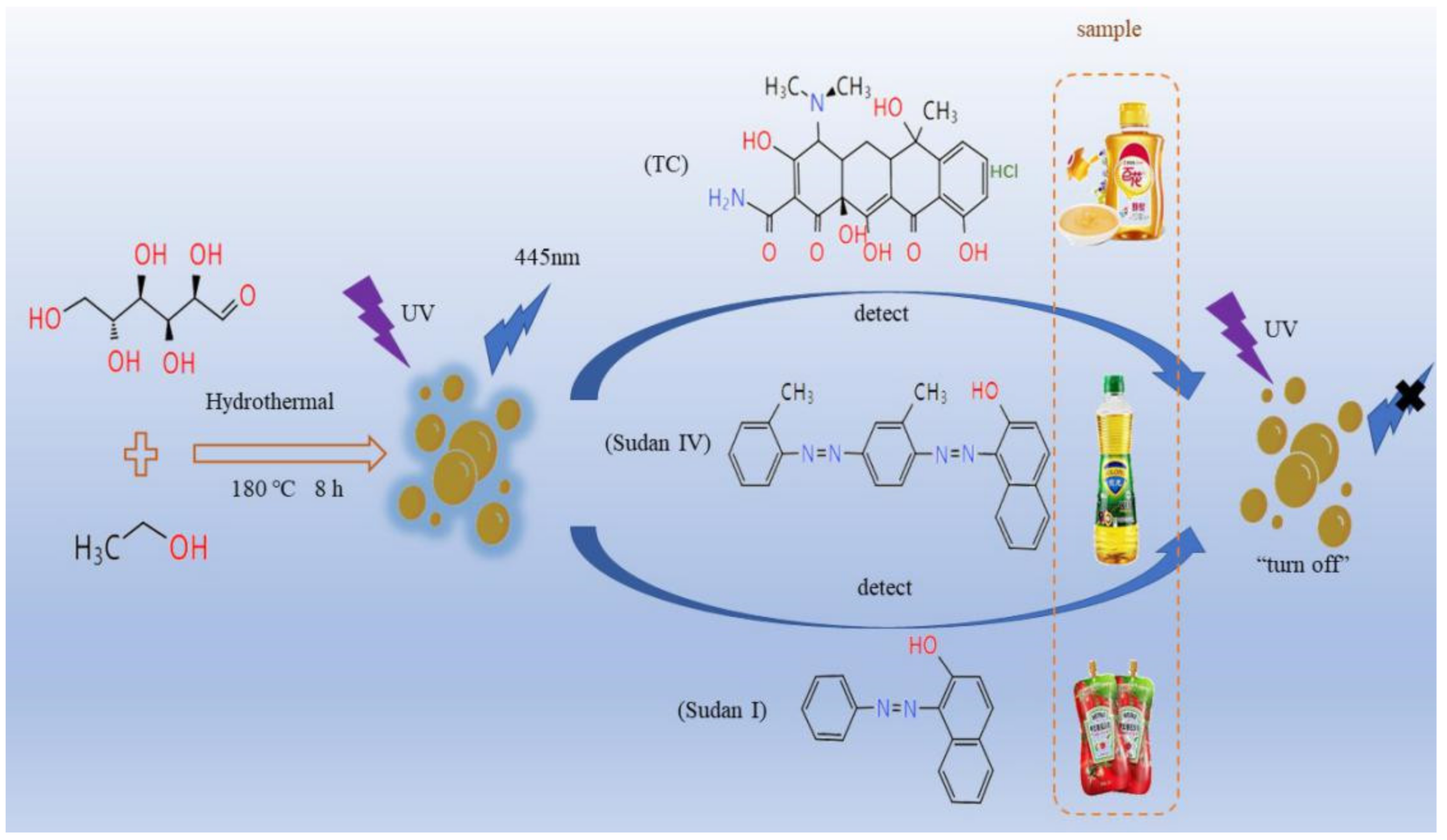



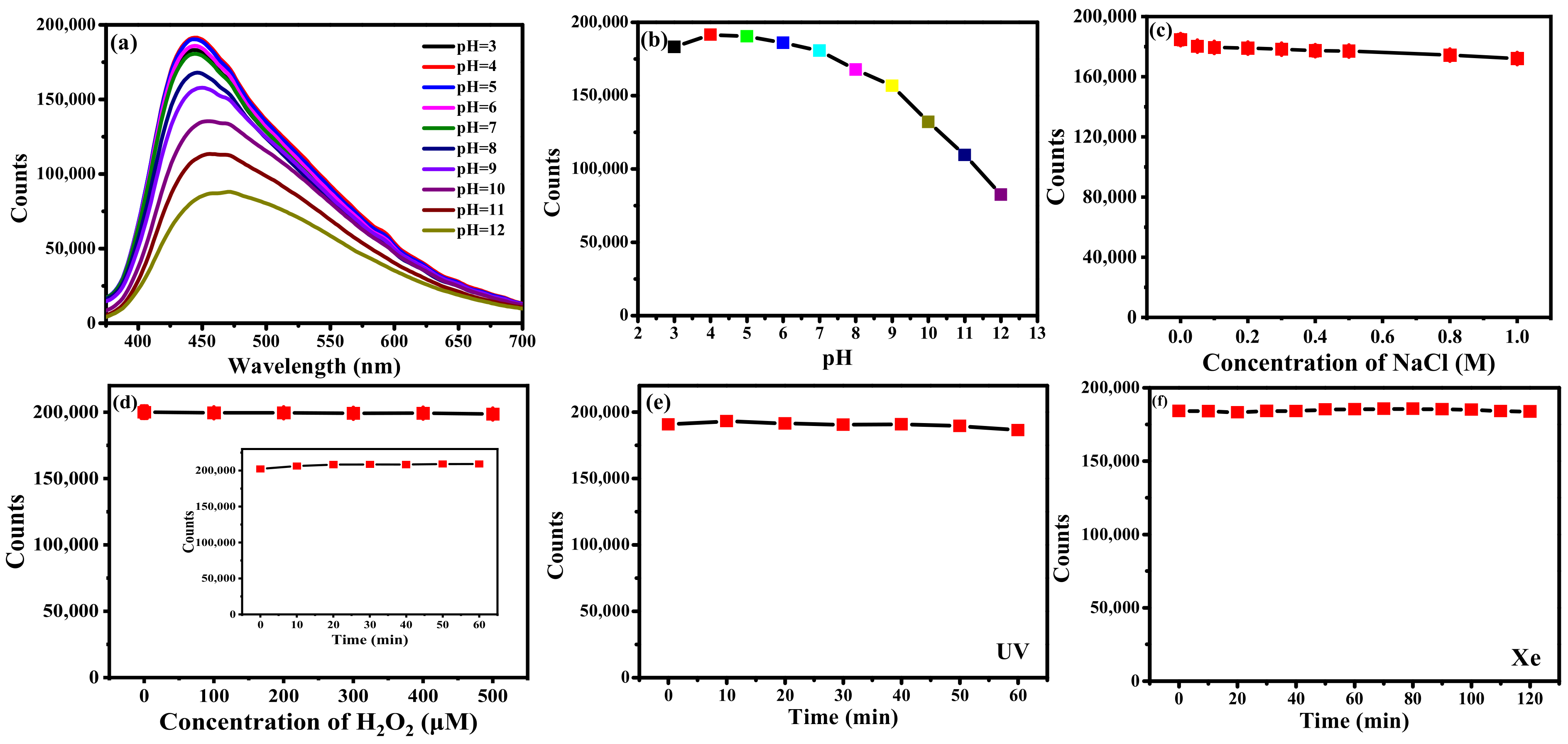
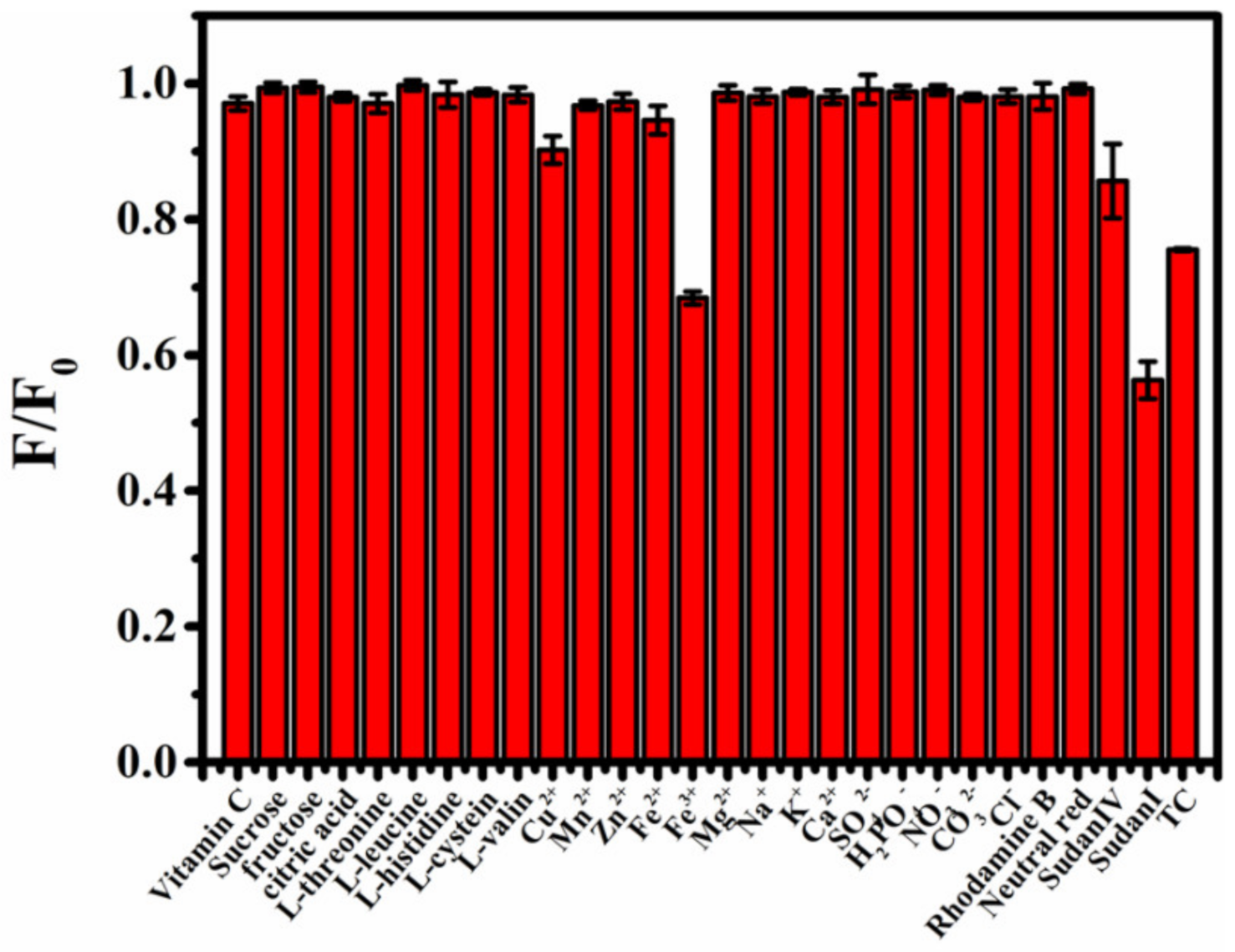

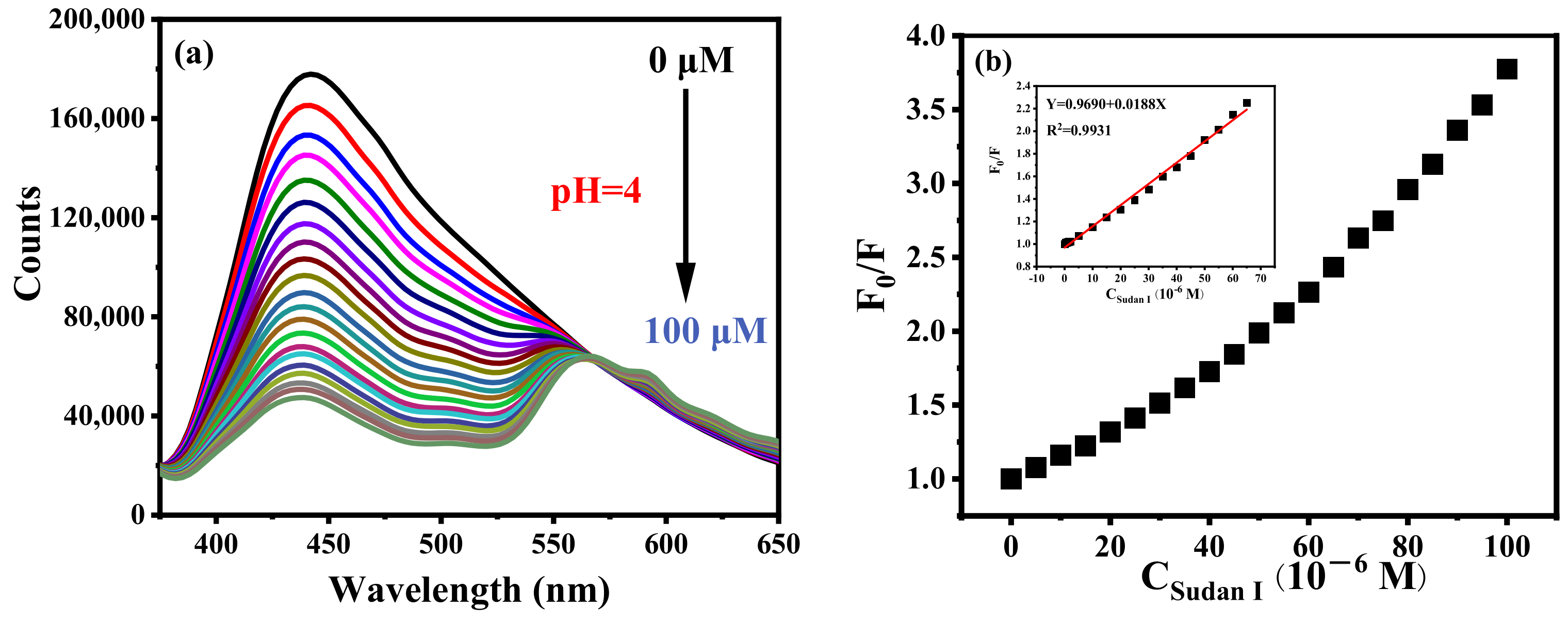
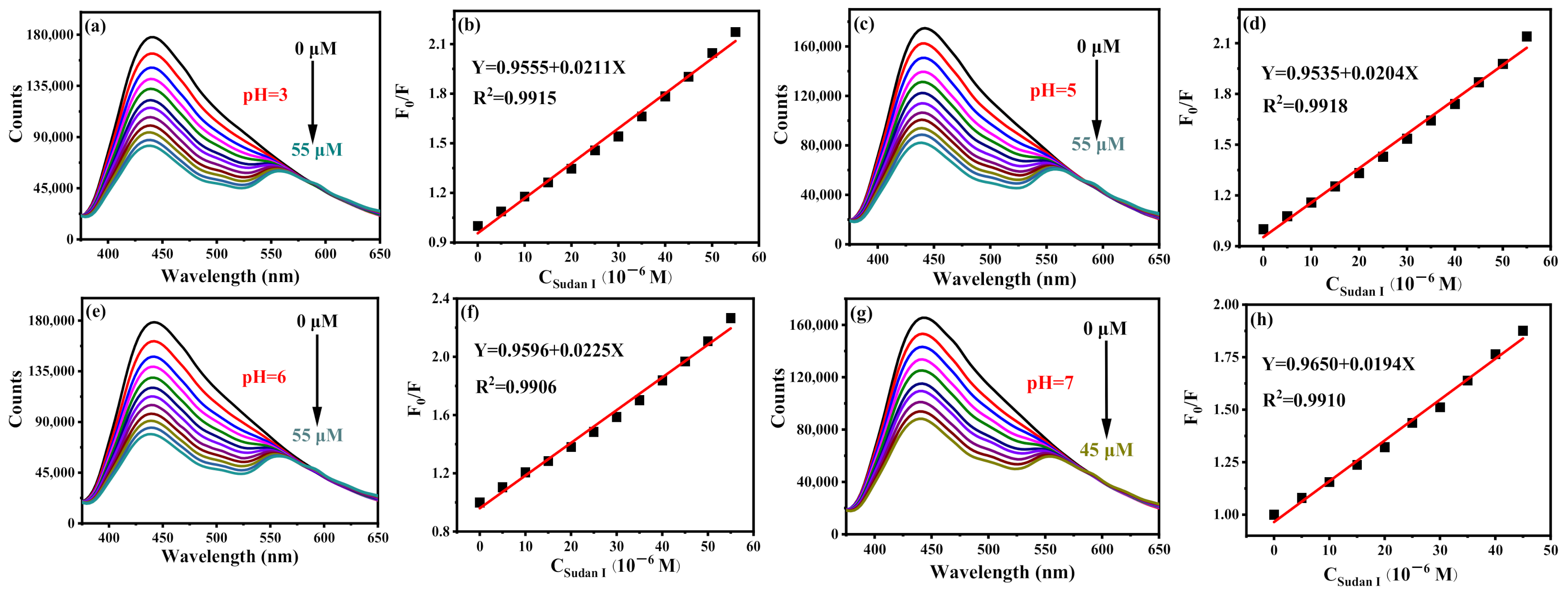

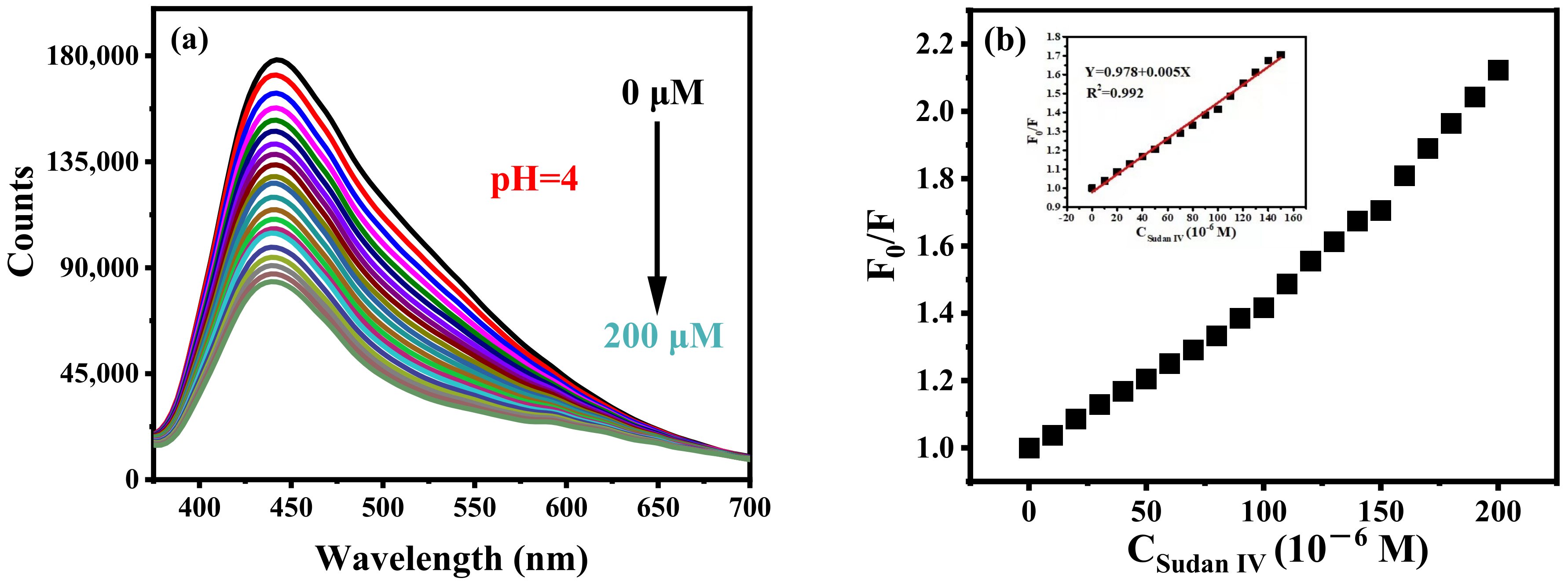

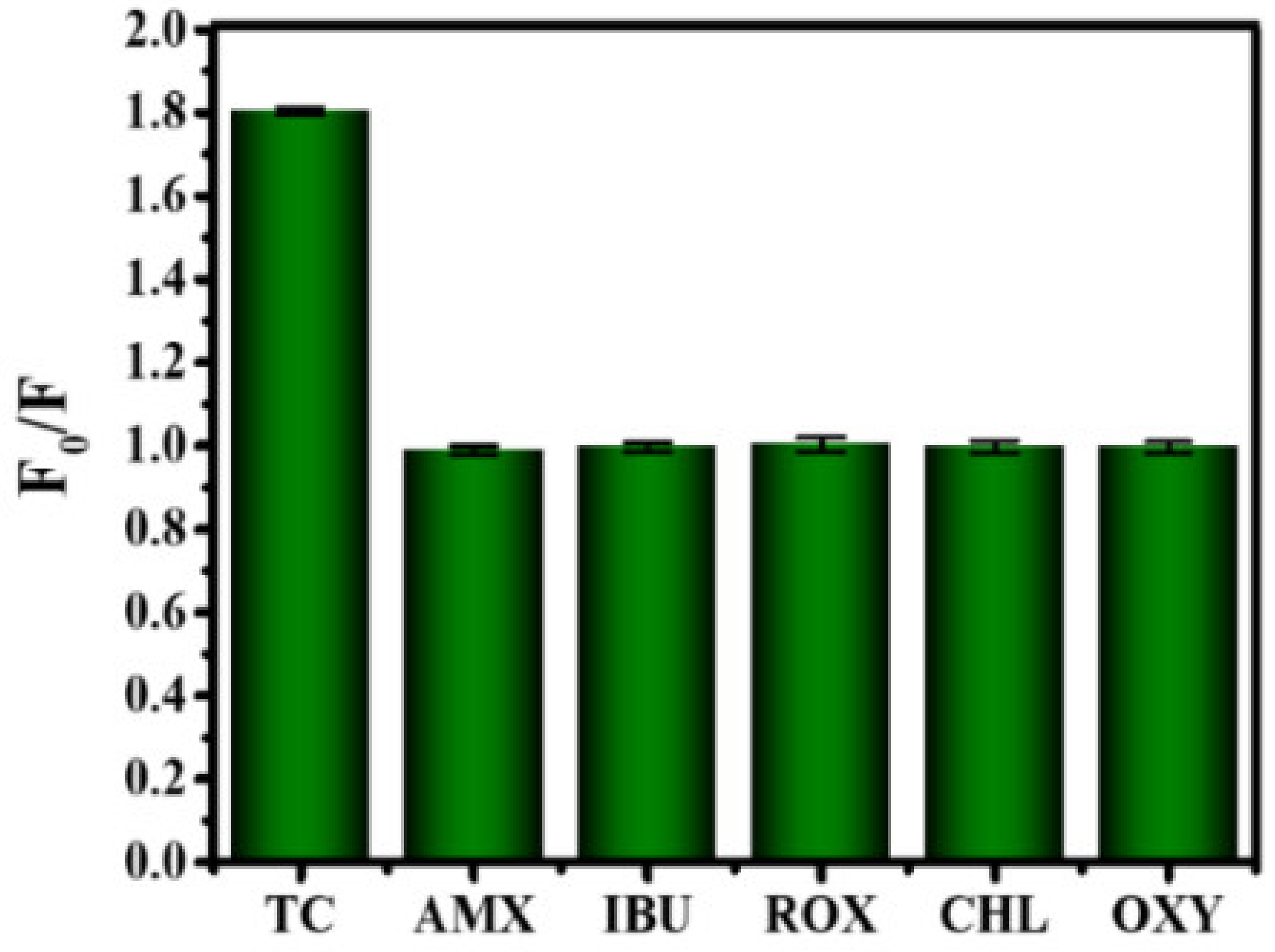





| Condition | Linear Range (µM) | Detection Limit (nM) | Application | References |
|---|---|---|---|---|
| S-CDs | 0–40 | 120 | Ketchup | [4] |
| P, N-CDs | 0.043–52 | 43 | - | [19] |
| Si NPs | 0.497–29.1 | 39 | Chili powder | [34] |
| [Ru(bpy)2(CIP)]2+ | 0.8–100 | 260 | Chili powder | [35] |
| 1,8-diamino naphthalene–Cu (II) | 0–4.6 | 32 | Chili powder | [36] |
| CsPbBr3QDs | 0.4–40 | 13.4 | Chili powder | [37] |
| B-CDs | 0.088–65 | 26.3 | Ketchup | This work |
| Condition | Linear Range (µM) | Detection Limit (nM) | Application | References |
|---|---|---|---|---|
| CDs | 10–400 | 6000 | - | [21] |
| CDs-electrospun nanofibers | 2–150 | 520 | Milk | [29] |
| CDs | 0.3–40 | 50 | Honey | [32] |
| GUCDs | 0.5–25 | 165 | Urine samples | [20] |
| Eu-CQDs | 0.5–200 | 300 | Water samples | [38] |
| N, Cl-GQDs | 0.2–30 | 68 | Water samples | [39] |
| CD–Eu3+ | 0–7.3 | 11.7 | Tap water, Ake water | [25] |
| B-CDs | 0.1–30 | 31.1 | Honey | This work |
| Detected Substance | Real Sample | Initial Amount (µM) | Spiked (µM) | Found (µM) | RSD (%) | Recovery (%) |
|---|---|---|---|---|---|---|
| Sudan Ⅰ | Ketchup | 0 | 3.00 | 2.88 ± 0.91 | 0.31 | 96.02 |
| 5.00 | 4.63 ± 0.53 | 0.57 | 92.61 | |||
| 15.00 | 13.91 ± 0.50 | 0.63 | 92.71 | |||
| Sudan Ⅳ | Palm oil | 0 | 10.00 | 9.47 ± 5.17 | 1.78 | 97.45 |
| 20.00 | 21.00 ± 2.54 | 2.44 | 100.19 | |||
| 30.00 | 30.73 ± 2.20 | 2.74 | 101.75 | |||
| TC | Honey | 0 | 4.00 | 4.38 ± 0.95 | 0.56 | 109.48 |
| 10.00 | 9.15 ± 1.66 | 0.93 | 91.54 | |||
| 15.00 | 13.55 ± 0.79 | 0.42 | 90.31 |
Publisher’s Note: MDPI stays neutral with regard to jurisdictional claims in published maps and institutional affiliations. |
© 2022 by the authors. Licensee MDPI, Basel, Switzerland. This article is an open access article distributed under the terms and conditions of the Creative Commons Attribution (CC BY) license (https://creativecommons.org/licenses/by/4.0/).
Share and Cite
Zhang, M.; Yu, H.; Tang, X.; Zhu, X.; Deng, S.; Chen, W. Multifunctional Carbon Dots-Based Fluorescence Detection for Sudan I, Sudan IV and Tetracycline Hydrochloride in Foods. Nanomaterials 2022, 12, 4166. https://doi.org/10.3390/nano12234166
Zhang M, Yu H, Tang X, Zhu X, Deng S, Chen W. Multifunctional Carbon Dots-Based Fluorescence Detection for Sudan I, Sudan IV and Tetracycline Hydrochloride in Foods. Nanomaterials. 2022; 12(23):4166. https://doi.org/10.3390/nano12234166
Chicago/Turabian StyleZhang, Min, Hongmei Yu, Xiaodan Tang, Xiuhui Zhu, Shuping Deng, and Wei Chen. 2022. "Multifunctional Carbon Dots-Based Fluorescence Detection for Sudan I, Sudan IV and Tetracycline Hydrochloride in Foods" Nanomaterials 12, no. 23: 4166. https://doi.org/10.3390/nano12234166






